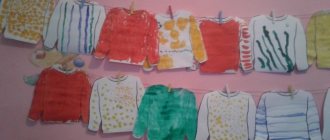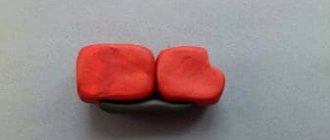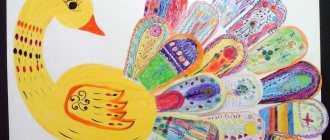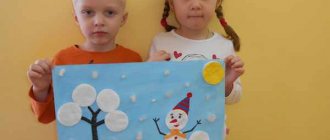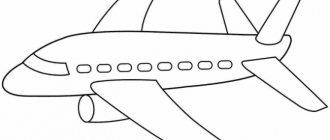Drawing lesson in the first junior group Topic: “Let’s decorate the tumbler”
Municipal preschool educational budgetary institution
"Kindergarten No. 4 of a combined type" Volkhov
Drawing class
in the first junior group
Topic: “Let’s decorate the tumbler”
Educator:
Ryabova I. Yu
Goal: to form in children an idea of the tumbler toy.
Tasks:
- teach children to decorate the silhouette of a tumbler with rhythmic strokes;
- arouse interest in reviving the applique image, in the search for visual and expressive means;
- cultivate a sense of color and shape.
Preliminary work:
Looking at tumblers of different sizes.
Clarification of the understanding of the meaning of the word “tumbler - a doll that does not fall, does not roll, does not lie down.”
Examination of the shape of a tumbler toy.
Modeling tumblers on the street from snow.
Comparison of tumblers with matryoshka.
Materials:
Sheets of white paper with silhouettes of tumblers pasted on by children, cotton swabs, brushes, paper and cloth napkins, paints, jars of water.
Progress lesson
We look at the tumbler and read an excerpt of the text of a Norwegian song:
- Dance, my doll
Dance more fun
Dance more fun
Don't be sorry for your heels.
- Guys, who is this?
Children's answers tumbler
- That's right guys! Why is she called that? (she doesn’t lie down, doesn’t roll around, but gets back up).
- The tumbler's body is round and its head is round. What shape is the body, what shape is the head?
Children's answers: round
- Guys, look at your tumblers. What do they lack?
Children's answers
- That's right, guys, they don't have any eyes, nose, or mouth. Let's draw the tumbler's face.
Children's answers
To do this, we will take a cotton swab, dip it in black paint and apply it to the face. It turned out to be an eye and another one. Then turn the stick with the other end and dip it in red paint. Let's draw a mouth.
Children draw
- These are the funny tumblers we got.
While the tumbler's face is drying up, a didactic game: “decorate the tumbler's dress.”
A tumbler is laid out on a flannelgraph; we invite children to decorate her dress with white peas.
- Now look, guys, our tumbler turned out to be ugly, let’s decorate her dress.
We take a brush, dip it in white paint and apply the entire pile to the dress. You can also decorate the dress with short lines, they can be arranged from top to bottom, or from left to right (teacher demonstration). To make peas, you need to dip the brush in the paint, apply the tip of the brush to the dress and remove it. These are the tumblers I got. After work, they form a round dance, and at this time we dance the dance: “We are cuties, tumbler dolls.” After the dance we look at our drawings.
Lesson 58. Decorative drawing “Decorate your toys”
Program content. Develop aesthetic perception. Continue to introduce children to Dymkovo toys, teach them to note their characteristic features, and highlight the elements of the pattern: circles, rings, dots, stripes. Strengthen children's understanding of the bright, elegant, festive colors of toys. Reinforce brush painting techniques.
Lesson 59. Application “Cut out and paste a beautiful flower as a gift for your mother and grandmother”
Program content. Learn to cut and paste a beautiful flower: cut out parts of the flower (cutting corners by rounding or slanting), and make a beautiful image out of them. Develop a sense of color, aesthetic perception, figurative ideas, imagination. Cultivate attention to family and friends.
Lesson 60. Modeling according to plan
Program content . Continue to develop independence, imagination, creativity. Strengthen sculpting techniques and the ability to use materials carefully.
March
Lesson 61. Drawing “Beautiful flowers have bloomed”
Program content. Teach children to draw beautiful flowers using a variety of shaping movements, working with the whole brush and its end. Develop aesthetic senses (children should carefully select paint colors), a sense of rhythm, and ideas about beauty.
Lesson 62. Application “A beautiful bouquet as a gift to all women in kindergarten” (team work)
(Option: Decorative applique on a square)
Program content. Cultivate a desire to please others, to create something beautiful for them. Expand children’s figurative ideas, develop the ability to create images of the same objects in different, variable ways. Continue to develop team creativity skills. Induce a feeling of joy from the created image.
Lesson 63. Modeling “Bowl”
Program content. Teach children to sculpt using already familiar techniques (rolling out a ball, flattening) and new ones - pressing and pulling the edges, leveling them with your fingers.
Lesson 64. Application “Cut out and paste what is round and oval”
(Option: Application “Cut out and stick whatever toy you want”)
Program content. Teach children to choose a topic of work in accordance with certain conditions. Develop the ability to bring your plan to completion. Develop creativity and imagination. Practice cutting the corners of a rectangle and square, rounding them. Strengthen your neat gluing skills.
Lesson 65. Decorative drawing “Let’s decorate the doll’s dress”
Program content. Teach children to make a pattern from familiar elements (stripes, dots, circles). Develop creativity, aesthetic perception, imagination.
Lesson 66. Modeling “Little Goat”
Program content. Teach children to sculpt a four-legged animal (oval body, head, straight legs). Strengthen sculpting techniques: rolling between the palms, attaching parts to the sculpted body of the animal, smoothing out the fastening points, pinching, etc. Develop sensorimotor experience.
Lesson 67. Drawing “The little goats ran out for a walk on the green meadow”
Program content. Continue teaching children to draw four-legged animals. Reinforce the knowledge that all four-legged animals have an oval body. Learn to compare animals, see what is common and what is different. Develop imaginative ideas, imagination, creativity. Learn to convey fairy-tale images. Strengthen the techniques of working with a brush and paints.
Lesson 68. Modeling “The bunnies jumped out into the clearing to nibble the green grass”
Program content . Teach children to sculpt an animal; convey the oval shape of his body, head, ears. Reinforce the techniques of sculpting and connecting parts. Develop the ability to create a collective composition. Develop figurative ideas and imagination.
Lesson 69. Drawing “How we played the outdoor game “Homeless Hare””
Program content. Develop children's imagination. To develop the ability to convey the plot of the game and images of animals in a drawing using expressive means (shape, position of an object in space). Continue to develop interest in a variety of creative activities.
Summary of the drawing lesson “Painting Christmas tree decorations”
Program content 1. Learn to decorate a Christmas tree decoration using painting elements: lines, strokes, dots, using the non-traditional drawing technique “tamponing”, drawing with cotton swabs. Develop the ability to analyze and compare, draw conclusions. 2. Develop artistic and creative abilities, aesthetic taste, cognitive interest in the traditions and customs of one’s people. 3. Develop the ability to listen carefully to the teacher, comrades, and give reasons for your answer. Preliminary work : making Christmas tree decorations from salt dough, conversation about Christmas tree decorations. Equipment. For the teacher: projector, multimedia board, Christmas tree, Christmas tree decorations, illustrations of vintage Christmas tree decorations, table with painting elements, toy painting schemes, video “Glassblowers”, music by Jan AP Kaczmarek – Goodbye. For children: a fake Christmas tree decoration, watercolor paints, a stamp pad, tampons with clothespins, brushes, cotton swabs, wet and dry wipes, aprons.
Progress of the lesson
1. Organizational moment. - Hello, dear guests! We welcome guests as if they were good news. There is a place for everyone and a kind word. — I want to invite you to a mini-museum, guess which one. At least not pine cones, not needles, but hanging on the branches of a Christmas tree. (Christmas decorations) 2. Main part. - That's right, these are Christmas tree decorations! How did you guess? - Not a single New Year's holiday is complete without Christmas tree decorations. — Who makes Christmas tree decorations? (craftsmen, artists, glassblowers) - There are a variety of toys. Let's look at them in our mini-museum. Comparison of ancient and modern Christmas tree decorations. - How do ancient Christmas tree decorations differ from modern ones? (Not so bright, most often ancient toys were depicted in the form of animals, people) - What materials can Christmas tree toys be made from? (Glass, foam plastic, plastic, fabric, wood) - And when these materials were not available, how could they decorate the Christmas tree? (ribbons, rags, candies, nuts, gingerbread cookies, candles, cookies, etc.) (Showing photographs on a projector) - A few years later, craftsmen learned to blow colorful toys from glass. —What are these masters called? (Glassblowers) - Let's see how glassblowers make glass toys? (Display video on a multimedia board) - What should a Christmas tree toy be? (Ornate, bright, beautifully decorated) - Decorating a Christmas tree decoration is an art! I invite you to an art workshop, where we will become real artists in decorating (painting) toys. We made the Christmas tree decorations in advance. (Children put on aprons) - Schemes will help us in decorating New Year's toys. 1. First: cover the toy with paint. Choose a color from those offered. On your table are boxes with a sponge soaked in gouache and using tampons, apply paint. The technique is called tamponing, from the word tampon. Let's say it in unison! (Plugging)2. Second: using a brush, a cotton swab and watercolor paints, we draw patterns and elements. - Let us repeat, once again in order, how you will decorate the gingerbread. (Children say) - What rules should we remember when working with a brush? (Each time after applying paint, the brush is washed. We do not leave the brushes in a glass of water) - There are wet and dry napkins on the tables, what might you need them for? (Wipe your hands, or remove any imperfections while drawing) - Before we start working, let's stretch our fingers: We are not masters yet, We are still learning. (unclenching fists) If we try, (joining fingers starting with the thumb) We will learn a lot. (we clasp our hands, raise our fingers up) - Now move the chairs closer, straighten the backs, watch your posture, let's start painting the Christmas tree decoration, I will help you a little. And for a good mood, we will draw to the music. (Music played by Jan AP Kaczmarek - Goodbye) Children decorate a toy. 3. Final part. - Guys, look how beautiful, bright and elegant your New Year's toys turned out to be. Now take them, put them on napkins and come to me. — Well done, you are wonderful artists, you showed all your creative skills! Now let's decorate our Christmas tree! You like? The Christmas tree turned out to be an elegant beauty! I think that you can make such miracles with your own hands for any holiday at home and in kindergarten.
